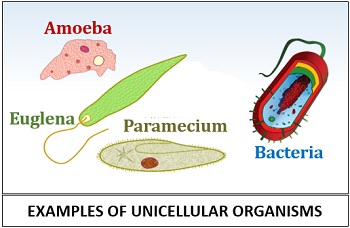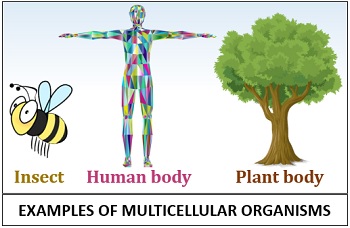The difference between unicellular and multicellular organisms is primarily due to cell composition, function, and arrangement. Unicellular organisms exist as an individual cell, whereas multicellular organisms possess a group of specialized cells.
Unicellular organisms mediate all their cellular activities by a single cell itself, while multicellular organisms perform specific cell activities through their specialized or distinct group of cells. The cell arrangement is much simpler in unicellular organisms, whereas multicellular organisms have a complex cell arrangement.
Both unicellular and multicellular organisms are the two major categories of the cell type, depending on cell number, shape, and size. In this post, we will study the key differences and similarities between the unicellular and multicellular organisms, along with the definition of the two.
Content: Unicellular vs Multicellular Organisms
Comparison Chart
| Properties | Unicellular Organisms | Multicellular Organisms |
|---|---|---|
| Cell number | Single cell | Multiple cells |
| Cell size | Small | Comparatively large |
| Cell shape | Irregular | Definite |
| Cell organization | Simple | Complex |
| Nature | Microscopic | Macroscopic |
| Cell type | They include organisms of both prokaryotic and eukaryotic cell type | They include organisms of only eukaryotic cell type |
| Cell differentiation | Generally absent, but unicellular yeasts may undergo differentiation | Specialized cell differentiation occurs |
| Life span | Short | Longer |
| Division of labour | Limited to the organelle level | Specified to cellular, tissue and organ system level |
| Operational efficiency | Low | High |
| Regeneration ability | Greater tendency to regenerate | Low regeneration ability |
| Reproduction methods | Budding and binary fission | Gamete fusion |
| Transport mechanism | The transport mechanism for food and water occurs through simple diffusion | The transport mechanism for food and water occurs by the diffusion, active and passive transport methods |
| Examples | Bacteria, Protozoans, unicellular amoeba etc. | Humans, animals, plants etc. |
Definition of Unicellular Organisms
They refer to the living organisms, which possess a single cell only to perform different life processes or cellular activities in the cytoplasm. It includes prokaryotic organisms like bacteria and archaea and eukaryotic organisms like protozoa, unicellular algae and yeasts.

One of the most common features of unicellular organisms is their microscopic nature, i.e. unobservable through the naked eye. They commonly reproduce via asexual methods like budding, fragmentation and binary fission.
But a few reproduce sexually via conjugation (like bacteria and protists). Because of single-cell composition, the cell arrangement is quite simple. They can thrive in extreme heat, acidity, salinity, and other environmental stresses.
Definition of Multicellular Organisms
They refer to living organisms, which possess multiple cells with distinct cell organelles that perform separate cellular activities or different life processes within a body. It only includes eukaryotic organisms like insects, animals, birds, human etc.

One of the most common features of a multicellular organism is its macroscopic nature, i.e. easily noticeable through the open eye. They commonly reproduce via sexual methods (by the formation of a zygote).
But, few members can grow via asexual means like budding and spore formation. Because of multiple cell composition, it has a composite cell arrangement. Organism’s size increases as the cell number increases.
Key Differences Between Unicellular and Multicellular Organisms
- Unicellular organisms appear small and single-celled, whereas multicellular organisms are large-sized, containing multiple cells.
- The cell arrangement of unicellular organisms is incomplex than the multicellular organisms.
- Unicellular organisms are microscopic, i.e. only evident under the microscope, whereas multicellular organisms are macroscopic, i.e. detectable with the naked eye.
- Unicellular organisms include microorganisms of both prokaryotic (bacteria, archaea, etc.) and eukaryotic (protozoa, unicellular algae, unicellular fungi, etc.) cell type. In contrast, human, animal, higher and lower plants have a multicellular eukaryotic cell type.
- The division of labour in unicellular organisms is limited to the organelle level, while it is specified to cellular, tissue, and organ system levels in multicellular organisms.
- Due to single-cell and high workload, the unicellular organisms have a shorter life span and lower operational efficiency than the multicellular species.
- Unicellular organisms generally do not undergo cell differentiation, except unicellular yeasts. Oppositely, multicellular organisms undergo specific cell division to form differentiated cells, mediating particular tasks within a living system.
- The members with multiple cell-type lose the regeneration ability over a period of cell growth and differentiation or cell ageing. Oppositely, unicellular organisms are immortal, as they have a considerable tendency of regenerating themselves.
Similarities
- Both single and multi-celled organisms originate from a functional unit of life, known as “Cells”.
- The presence of plasma membrane and cytoplasm occurs in both types.
- Both the organisms share a similar feature by containing DNA and ribosomes for gene expression.
- The process of cell division typically occurs in both types, commonly through mitosis or meiosis.
- Both organisms need cellular energy to function.
Conclusion
Therefore, we can conclude that a cell can be unicellular and multicellular type, which undergoes the same life processes like respiration, digestion, excretion etc., to sustain life.
A significant difference is in a cell number that creates a significant difference in cellular function, work efficiency, cell arrangement etc., of the unicellular and multicellular organisms.
The unicellular organisms have a single cell due to which their function is fully dependent on a single cell only, which eventually reduces the working efficiency and life span of the organisms due to heavy workload.
In contrast, multicellular species possess multiple cells to perform distinct tasks by coordinating different cells and eventually promotes high working efficiency and a long life span due to the division of cell labour.